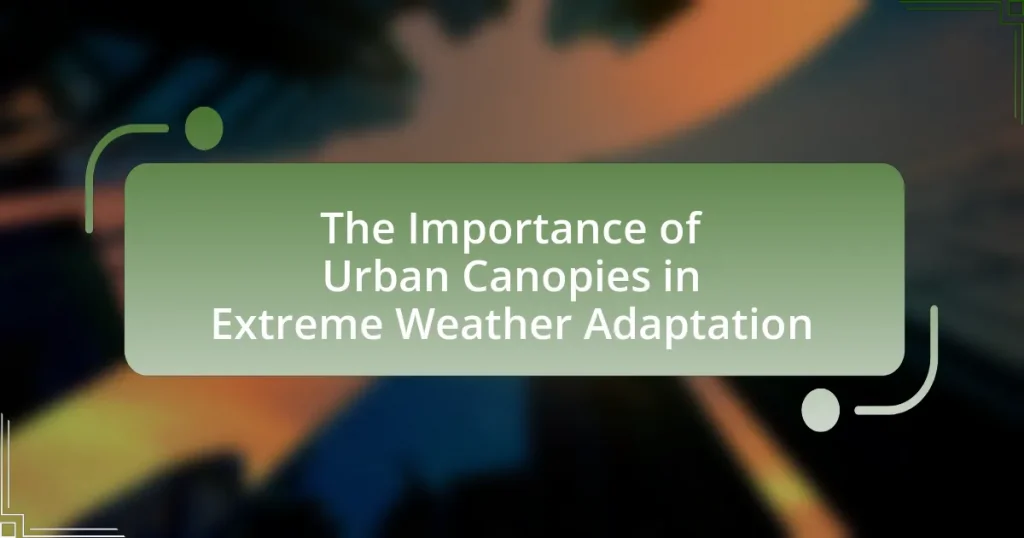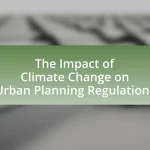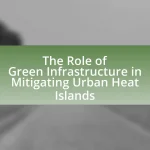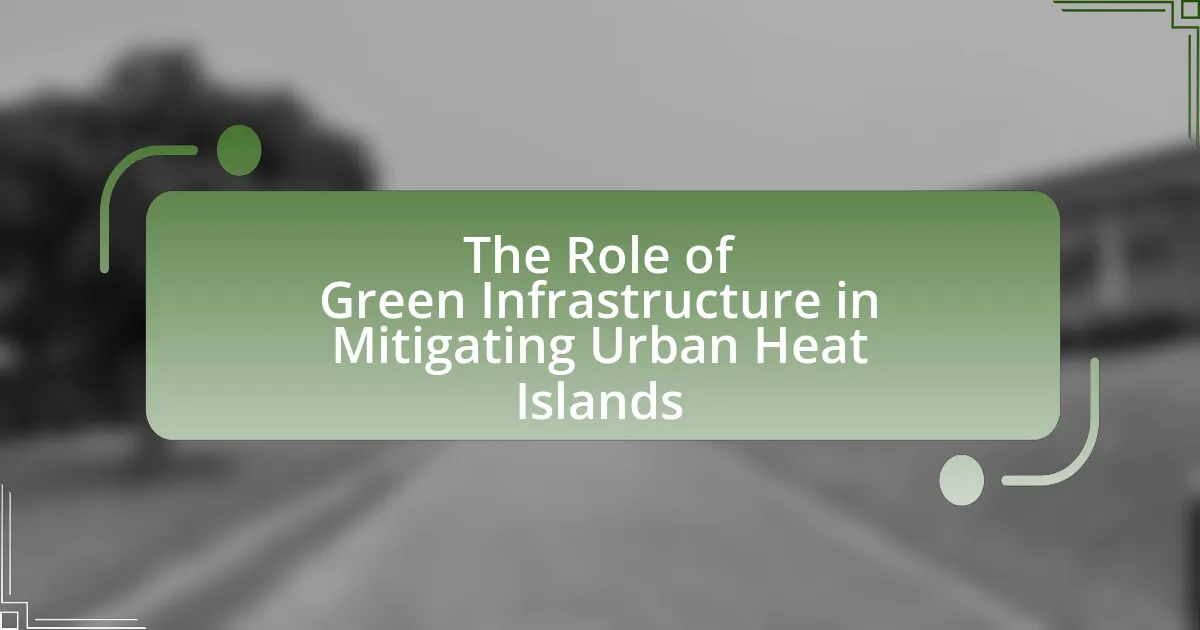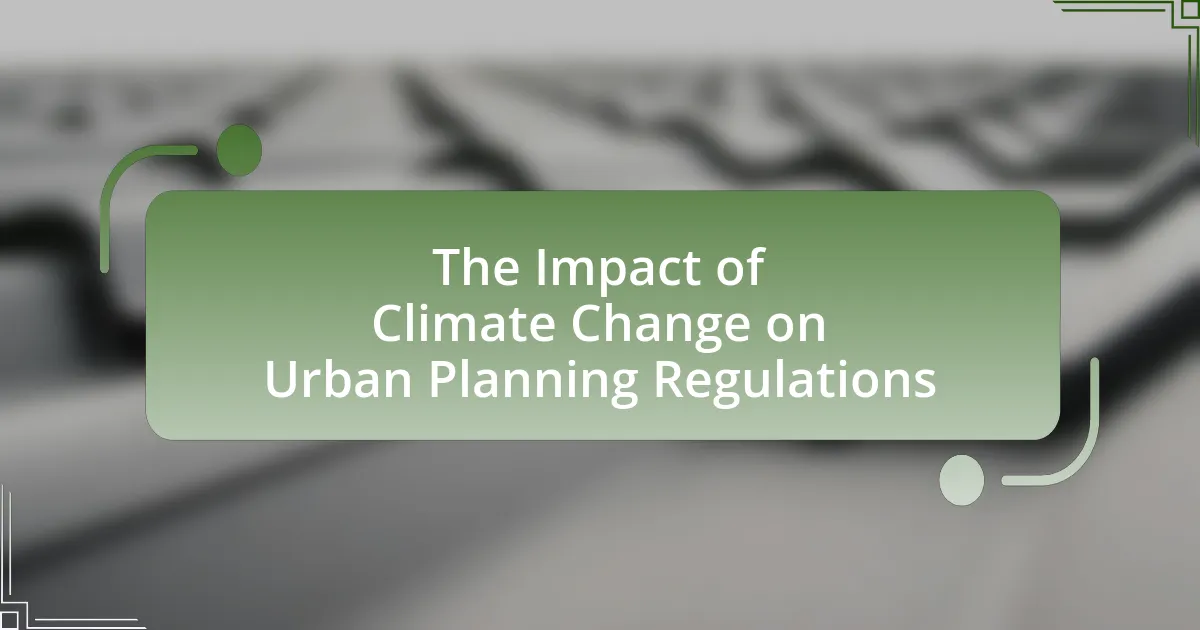Urban canopies, primarily composed of trees and vegetation in urban areas, play a vital role in adapting to extreme weather conditions. They provide essential benefits such as reducing heat through shade and evapotranspiration, managing stormwater to alleviate flooding, and improving air quality by filtering pollutants. The article explores how urban canopies mitigate the urban heat island effect, enhance biodiversity, and contribute to community resilience during extreme weather events. Additionally, it addresses the challenges faced by urban canopies, including pollution and climate change, and outlines best practices for their maintenance and integration into urban planning.
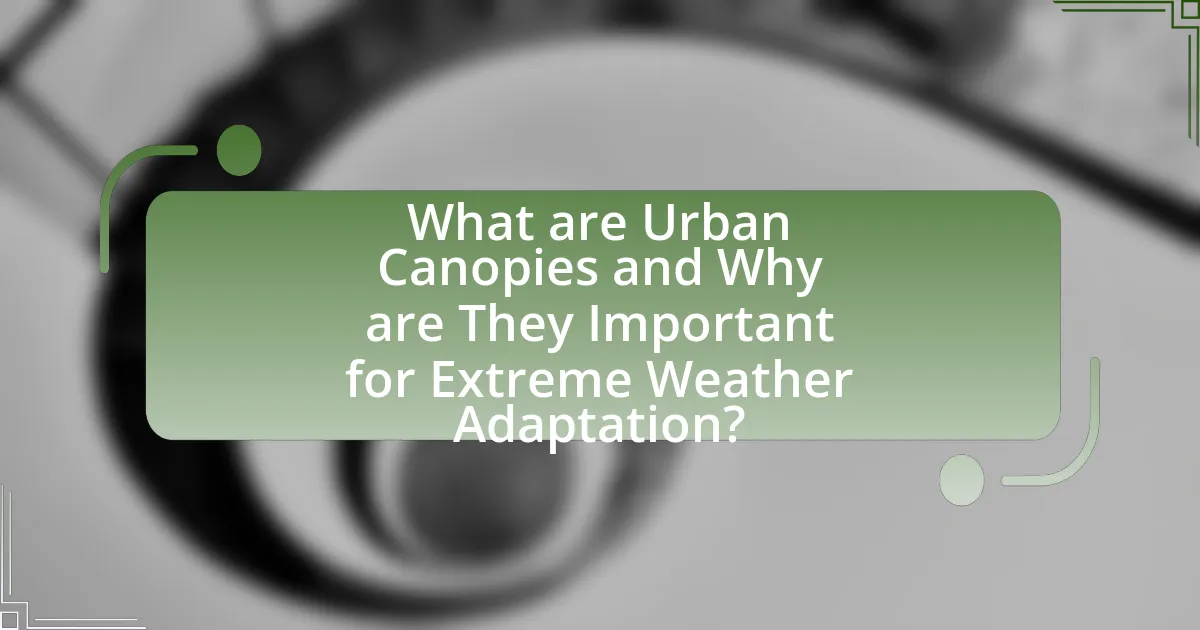
What are Urban Canopies and Why are They Important for Extreme Weather Adaptation?
Urban canopies refer to the layer of vegetation, primarily trees, that exists in urban areas, providing shade and cooling effects. They are crucial for extreme weather adaptation as they mitigate heat, reduce stormwater runoff, and improve air quality. Studies show that urban canopies can lower surface temperatures by up to 10 degrees Fahrenheit, significantly reducing the urban heat island effect. Additionally, they enhance resilience against flooding by absorbing rainfall, thereby decreasing the burden on drainage systems.
How do Urban Canopies function in mitigating extreme weather effects?
Urban canopies function in mitigating extreme weather effects by providing shade, reducing heat, and managing stormwater. These canopies, primarily formed by trees and vegetation, lower surface and air temperatures through evapotranspiration, which can decrease urban heat islands by up to 5 degrees Fahrenheit. Additionally, urban canopies intercept rainfall, reducing runoff and flooding risks, as studies show that trees can absorb up to 30% of rainfall. This dual function of cooling and water management enhances urban resilience against extreme weather events.
What specific weather conditions can Urban Canopies help alleviate?
Urban canopies can help alleviate extreme heat and heavy rainfall. Specifically, they reduce urban heat island effects by providing shade and cooling through evapotranspiration, which can lower surface and air temperatures significantly. Studies indicate that urban areas with increased tree canopy cover can experience temperature reductions of up to 5 degrees Fahrenheit. Additionally, urban canopies mitigate stormwater runoff by intercepting rainfall, which helps reduce flooding and erosion. Research shows that trees can absorb up to 30% of rainfall, thereby decreasing the volume of water that reaches the ground and the drainage systems.
How do Urban Canopies interact with urban infrastructure during extreme weather?
Urban canopies interact with urban infrastructure during extreme weather by providing shade, reducing heat, and managing stormwater runoff. These canopies mitigate the urban heat island effect, which can lead to increased energy demand and heat-related health issues during heatwaves. For instance, studies show that tree canopies can lower surface temperatures by up to 10 degrees Fahrenheit, thereby reducing the strain on cooling systems in buildings. Additionally, urban canopies enhance stormwater management by intercepting rainfall, which decreases runoff and flooding risks. Research indicates that trees can absorb up to 30% of rainfall, helping to prevent urban flooding and protect infrastructure.
What ecological benefits do Urban Canopies provide in urban settings?
Urban canopies provide significant ecological benefits in urban settings, including improved air quality, reduced urban heat, and enhanced biodiversity. These canopies filter pollutants from the air, absorbing carbon dioxide and releasing oxygen, which contributes to cleaner air. Studies indicate that urban trees can reduce ambient temperatures by up to 10 degrees Fahrenheit, mitigating the urban heat island effect, which is crucial during extreme weather events. Furthermore, urban canopies create habitats for various species, promoting biodiversity and supporting ecosystem services. For instance, a study published in the journal “Urban Forestry & Urban Greening” found that urban trees can support over 500 species of birds and insects, highlighting their role in maintaining ecological balance in cities.
How do Urban Canopies contribute to biodiversity in cities?
Urban canopies significantly enhance biodiversity in cities by providing habitats and resources for various species. These canopies create microclimates that support diverse flora and fauna, facilitating the presence of birds, insects, and other wildlife. Research indicates that urban trees and vegetation can increase species richness; for instance, a study published in the journal “Urban Forestry & Urban Greening” found that urban green spaces can support up to 30% more bird species compared to areas without vegetation. Additionally, urban canopies contribute to ecological connectivity, allowing species to move and thrive within fragmented urban landscapes.
What role do Urban Canopies play in improving air quality?
Urban canopies significantly improve air quality by filtering pollutants and absorbing carbon dioxide. Trees and vegetation within urban canopies capture particulate matter, such as dust and smoke, which reduces airborne contaminants. Studies indicate that urban trees can remove approximately 1.7 million tons of air pollution annually in the United States alone, leading to better respiratory health for city inhabitants. Additionally, the presence of urban canopies can lower temperatures through shade, which helps decrease the formation of ground-level ozone, a harmful air pollutant.
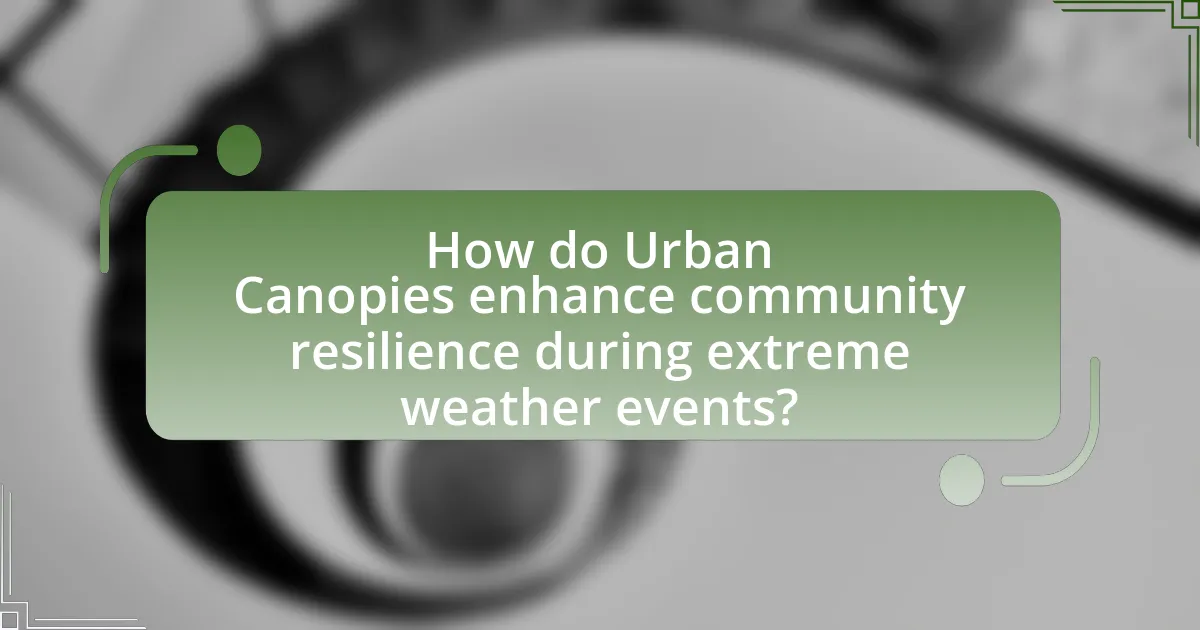
How do Urban Canopies enhance community resilience during extreme weather events?
Urban canopies enhance community resilience during extreme weather events by providing shade, reducing heat, and managing stormwater. These canopies, primarily formed by trees and vegetation, lower urban temperatures through evapotranspiration, which can mitigate the urban heat island effect. For instance, a study by the U.S. Forest Service found that urban trees can reduce surface temperatures by up to 10 degrees Fahrenheit, significantly lowering heat-related health risks during heatwaves. Additionally, urban canopies improve stormwater management by intercepting rainfall, reducing runoff, and decreasing the risk of flooding. Research indicates that a 10% increase in tree canopy cover can lead to a 20% reduction in stormwater runoff, enhancing the community’s ability to cope with heavy rainfall events.
What social benefits arise from the presence of Urban Canopies?
Urban canopies provide significant social benefits, including improved mental health, enhanced community cohesion, and increased recreational opportunities. Research indicates that green spaces, such as those created by urban canopies, reduce stress and promote well-being, as evidenced by a study published in the Journal of Environmental Psychology, which found that exposure to greenery can lower cortisol levels and improve mood. Additionally, urban canopies foster social interactions by creating inviting spaces for community gatherings, thereby strengthening neighborhood ties. Furthermore, they offer recreational areas that encourage physical activity, contributing to overall public health.
How do Urban Canopies promote community engagement and well-being?
Urban canopies promote community engagement and well-being by providing shaded areas that encourage social interaction and outdoor activities. These green spaces serve as gathering spots for community events, fostering connections among residents. Research indicates that urban greenery, including canopies, enhances mental health by reducing stress and promoting physical activity, which is crucial for overall well-being. For instance, a study published in the journal “Environmental Science & Technology” found that access to green spaces can lead to a 30% increase in physical activity levels among urban residents. Additionally, urban canopies improve air quality and reduce urban heat, creating a more pleasant environment that further encourages community participation.
What are the economic advantages of investing in Urban Canopies?
Investing in urban canopies provides significant economic advantages, including reduced energy costs, increased property values, and enhanced public health. Urban canopies, primarily composed of trees and vegetation, lower ambient temperatures through shade, which can decrease air conditioning expenses by up to 30% in residential areas, as reported by the U.S. Department of Energy. Additionally, properties located near well-maintained urban canopies often see a 7% to 15% increase in value, according to studies by the Arbor Day Foundation. Furthermore, urban canopies contribute to improved air quality and reduced healthcare costs associated with pollution-related illnesses, with estimates suggesting that green spaces can save cities millions in healthcare expenditures.
How can Urban Canopies be integrated into urban planning and design?
Urban canopies can be integrated into urban planning and design by incorporating them into zoning regulations, landscape architecture, and infrastructure development. This integration can enhance urban resilience against extreme weather by providing shade, reducing heat islands, and improving air quality. For instance, cities like Melbourne have implemented policies that require tree canopies in new developments, resulting in a 10% reduction in urban heat. Additionally, urban canopies can be strategically placed in public spaces, such as parks and streets, to maximize their cooling effects and promote biodiversity.
What strategies can cities adopt to increase Urban Canopy coverage?
Cities can adopt several strategies to increase Urban Canopy coverage, including implementing tree planting initiatives, enhancing green infrastructure, and establishing urban forestry programs. Tree planting initiatives can involve community engagement to encourage residents to plant and care for trees, which has been shown to increase canopy coverage significantly. Enhancing green infrastructure, such as green roofs and permeable pavements, allows for more vegetation and tree growth in urban areas. Urban forestry programs can provide structured management and maintenance of trees, ensuring their health and longevity, which is crucial for sustaining canopy coverage. According to a study by the U.S. Forest Service, urban tree canopies can reduce temperatures by up to 10°F, demonstrating the effectiveness of these strategies in mitigating extreme weather impacts.
How can technology assist in the management of Urban Canopies?
Technology can assist in the management of urban canopies through the use of data analytics, remote sensing, and geographic information systems (GIS). These technologies enable urban planners and environmentalists to monitor tree health, assess canopy coverage, and optimize tree placement for maximum climate resilience. For instance, remote sensing technologies can provide high-resolution imagery that helps identify areas needing reforestation or maintenance, while GIS can analyze spatial data to inform decisions on urban greening initiatives. Studies have shown that cities employing these technologies can enhance their urban canopy coverage by up to 30%, significantly improving urban heat mitigation and air quality.
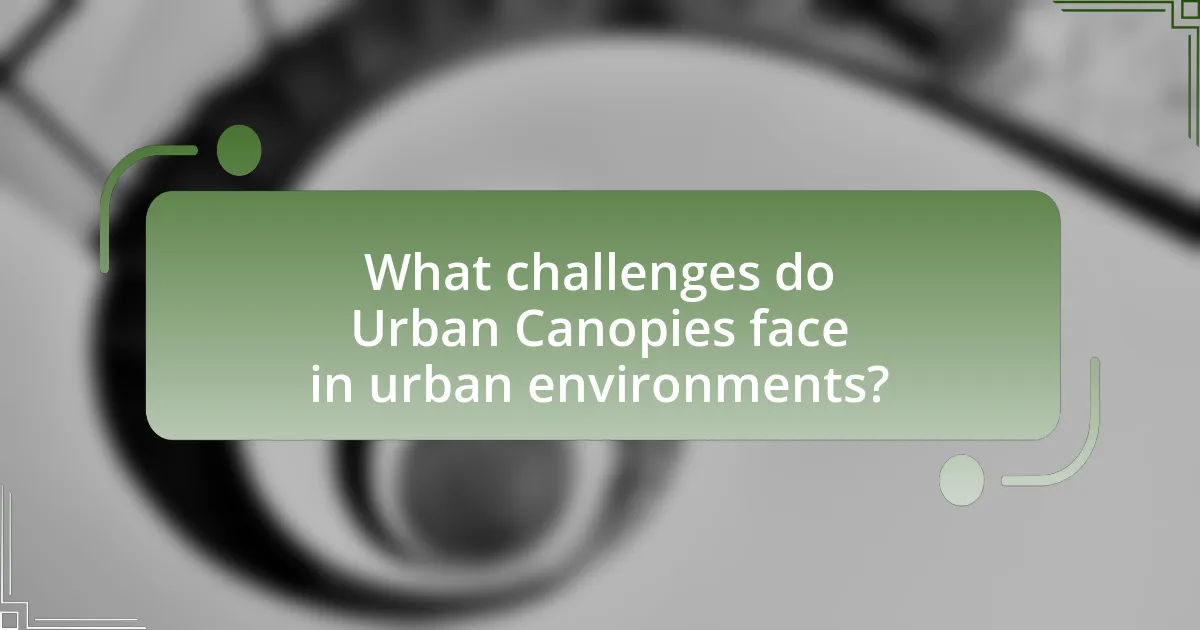
What challenges do Urban Canopies face in urban environments?
Urban canopies face several challenges in urban environments, including limited space for root growth, competition for resources, and susceptibility to pollution. Limited space restricts the ability of trees to establish healthy root systems, which can lead to poor growth and increased vulnerability to disease. Competition for resources, such as water and nutrients, arises from urban infrastructure and other vegetation, making it difficult for urban canopies to thrive. Additionally, urban pollution, including air and soil contaminants, negatively impacts tree health and longevity, reducing their effectiveness in mitigating extreme weather effects.
How do climate change and urbanization impact Urban Canopies?
Climate change and urbanization significantly impact urban canopies by altering their composition, health, and functionality. Climate change leads to increased temperatures and altered precipitation patterns, which can stress tree species and reduce canopy cover. For instance, studies indicate that urban areas experience higher temperatures, known as the urban heat island effect, which can lead to tree mortality and reduced growth rates. Urbanization contributes to habitat fragmentation and soil compaction, further hindering the establishment and maintenance of healthy urban canopies. Research shows that urban areas often have lower biodiversity, which affects the resilience of urban canopies to pests and diseases. Consequently, these factors collectively diminish the ability of urban canopies to provide essential services such as shade, air quality improvement, and stormwater management, which are crucial for adapting to extreme weather events.
What are the common threats to the health of Urban Canopies?
Common threats to the health of urban canopies include pollution, invasive species, climate change, and urban development. Pollution, particularly from vehicle emissions and industrial activities, can lead to poor air quality, which negatively affects tree health and growth. Invasive species can outcompete native plants, disrupting local ecosystems and diminishing biodiversity. Climate change contributes to increased temperatures and altered precipitation patterns, stressing urban trees and making them more susceptible to pests and diseases. Urban development often results in habitat loss and soil compaction, which can hinder root growth and water absorption, ultimately threatening the vitality of urban canopies.
How can cities address the challenges faced by Urban Canopies?
Cities can address the challenges faced by Urban Canopies by implementing comprehensive urban forestry programs that focus on planting, maintaining, and protecting trees. These programs can enhance biodiversity, improve air quality, and mitigate urban heat effects, which are critical in extreme weather scenarios. For instance, a study by the U.S. Forest Service found that urban trees can reduce surface temperatures by up to 10 degrees Fahrenheit, significantly lowering energy costs and improving public health during heat waves. Additionally, cities can adopt policies that prioritize green infrastructure, such as green roofs and permeable pavements, which support tree health and resilience. By investing in community engagement and education about the benefits of Urban Canopies, cities can foster public support for tree preservation and expansion initiatives, ensuring long-term sustainability and adaptation to climate challenges.
What best practices can be implemented for maintaining Urban Canopies?
Best practices for maintaining urban canopies include regular pruning, proper irrigation, and soil management. Regular pruning enhances tree health and structure, allowing for better air circulation and light penetration, which are crucial for growth. Proper irrigation ensures that trees receive adequate water, especially during dry spells, while soil management, including mulching and aeration, promotes root health and nutrient availability. Research indicates that well-maintained urban canopies can reduce urban heat by up to 10 degrees Fahrenheit, demonstrating their effectiveness in extreme weather adaptation.
How can communities participate in the care and maintenance of Urban Canopies?
Communities can participate in the care and maintenance of Urban Canopies by organizing tree planting events, conducting regular maintenance activities such as pruning and watering, and engaging in educational programs about the benefits of urban trees. These actions foster community involvement and enhance the health of urban canopies, which are crucial for mitigating extreme weather effects. Research indicates that urban trees can reduce heat by up to 10 degrees Fahrenheit, demonstrating their importance in climate adaptation.
What resources are available for cities to enhance Urban Canopy management?
Cities can enhance Urban Canopy management through various resources, including funding programs, technical guidelines, and community engagement initiatives. For instance, the Urban Forestry Program by the U.S. Forest Service provides financial assistance and best practices for tree planting and maintenance. Additionally, the Arbor Day Foundation offers resources such as tree care manuals and educational workshops to promote urban forestry. Research indicates that cities with robust urban canopy management can reduce heat island effects by up to 5°F, demonstrating the effectiveness of these resources in improving urban resilience to extreme weather.
